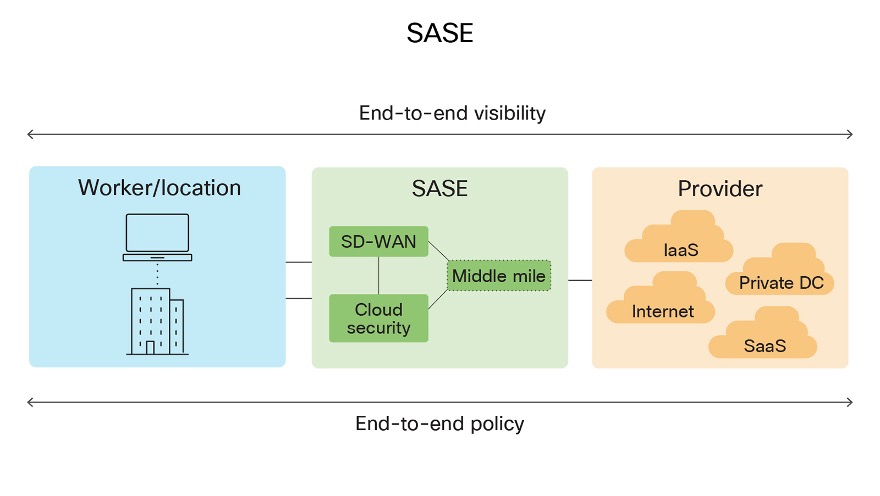Why SASE and why now?
In tech, the use of acronyms proliferates every conversation. And, often to our customer’s chagrin, it’s the same at Cisco. Another day, another acronym. ZTNA, MPLS, CASB, SDN, SWG – and the list goes on. But if there is one acronym that needs to be on every IT organization’s must-have security and networking strategy list—it is SASE. Like all new technologies, it takes time for IT teams to fully understand the implications and nuances associated with creating a roadmap for adoption. That’s why we thought it would be valuable to create a special edition of the 2022 Global Networking Trends Report focused purely on SASE – Special Edition: The State of SASE.
Secure access service edge (SASE) is an architectural model that converges networking and security functions in the cloud to deliver secure access to public cloud and on-premises applications, anytime and anywhere.

But why is there such an added emphasis now on securing access to cloud-based applications when cloud-based apps have been maturing for well over a decade? Two words – hybrid work. SASE has been pushed to the forefront because IT teams need to support an anywhere, everywhere multicloud access strategy for their multicloud applications to empower their remote workforces.
However, enabling a secure anywhere multicloud access strategy brings new challenges. The traditional perimeter security topology worked well when most applications and data resided inside the data center and campus walls. But now that applications and users are highly distributed with most data being generated outside corporate data centers and depending largely on a perimeter security model – new security risks and performance issues are coming to the surface.
By shifting security to the cloud and tightly integrating it with the network, SASE promises to reduce transport and operating costs, improve network flexibility and performance, and move the security closer to users and applications. SASE provides high-quality and consistent user experiences that are intended to connect and protect their teams no matter where they are located.
Taking the first step
When looking at how your organization should adopt SASE, it is important to look at it as a journey instead of a quick fix. One needs to assess overarching business and IT strategies and priorities already in place and outline next steps. The right SASE model and journey is unique to every organization. Each has different existing investments, operational models, critical initiatives, regulatory demands, mergers and acquisitions, supply chain operations, and business resilience requirements that must be considered. Whether starting with security or the network, it is important for IT teams to adopt a strategic planning approach that will incrementally build towards a complete SASE architecture over time.
Need more SASE knowledge?
In the Cisco® 2022 Global Networking Trends special edition, The State of SASE, we share SASE trends and insights as well as some tips from our experts on what you need to start your SASE journey. Learn what is driving SASE adoption, the role of SD-WAN in a SASE model, the important integrations you should consider, and the approach other IT teams are taking in their SASE adoption.
Whether you are well-versed in SASE or just learning about it, I encourage you to check out the resources below and see why SASE is the acronym most vital to your business.
Read the full Special Edition: The State of SASE
Additional Resources:
Check out our other Global Networking Trends Reports
Subscribe to Cisco’s Networking Blog




CONNECT WITH US